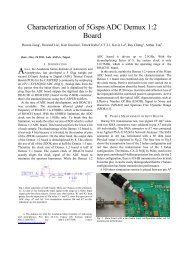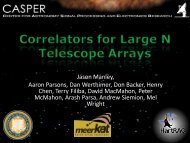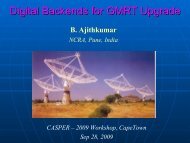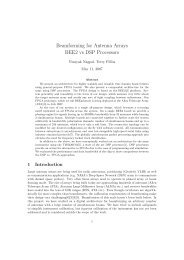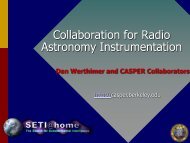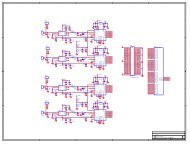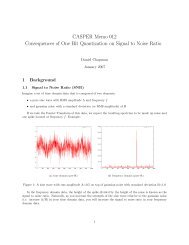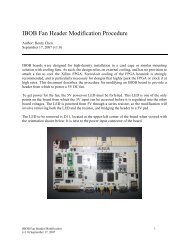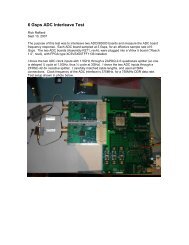Status, Capabilities, and Usage of the ATA Beamformer - CASPER
Status, Capabilities, and Usage of the ATA Beamformer - CASPER
Status, Capabilities, and Usage of the ATA Beamformer - CASPER
- No tags were found...
You also want an ePaper? Increase the reach of your titles
YUMPU automatically turns print PDFs into web optimized ePapers that Google loves.
<strong>Status</strong>, <strong>Capabilities</strong>, <strong>and</strong> Use<strong>of</strong> <strong>the</strong> <strong>ATA</strong> <strong>Beamformer</strong>Billy BarottJuly 8, 20081
OutlineIntroductionBasic UseHardwareFirmwareCalibration TheoryS<strong>of</strong>twareConcluding Thoughts2
Major Milestones2007 August: Prototype controls shown2007 October: 4-antennas2007 November: 24-antennas2008 March: First obs with BAPP2008 April: 42-antenna, two-pol, 1-beam2008 June: Second dual-pol b.f.Current: Upgrades, engineering tests…3
System LayoutThe <strong>ATA</strong> Synchronous Time-Domain<strong>Beamformer</strong><strong>Beamformer</strong>: The whole thing, with onemaster s<strong>of</strong>tware controllerBeam Processor: Independent FPGA treeBEE2: FPGA processing machineFPGA: Element <strong>of</strong> <strong>the</strong> BEE2 (one <strong>of</strong> 4)iBob: Processor with 4 ADC inputs4
Current <strong>Capabilities</strong>Two Independent Dual-pol beamformers• BF1: 42-ants, 18 FPGA (two x9 FPGA b.p.)• BF2: 36-ants, 16 FPGA (two x8 FPGA b.p.)Beam processors independently steeredWired for X <strong>and</strong> Y beam processors• Calibration on X/Y – No CP yet50 MHz analog, 72 MHz Digital B<strong>and</strong>widthIn Progress…• Let user modify coefficients• Better solar/ RFI h<strong>and</strong>ling in calibration5
Using <strong>the</strong> <strong>Beamformer</strong>*Detailed usage information onlog.hcro.org6
The Very Basic:InitializeCalibrateObserveScripts should be run on tumulus or user17
Initializing <strong>the</strong> <strong>Beamformer</strong>1. Verify <strong>ATA</strong> engineering status• Only observe with good feeds• Verify LNA / PAM / Focus settings2. Configure iBobs: bfibob• Walsh, Rearm, Sky, Autoatten3. Configure beamformer: bfinit.rb• -b [beamformer] -a [antlist]• bfinit.rb –b 1 –a 1ax,1bx,1cx8
Calibrating <strong>the</strong> <strong>Beamformer</strong>1. Strong Source Delay [--caldelay]• Flattens instrumental delays• Suggested: Cas-A, 3c274 (high SNR desired)2. Unresolved Phase [--calphase]• Aligns instrumental phase <strong>of</strong>fsets• Suggested: 3c84, 3c48, 0927+3903. (Optional) Wideb<strong>and</strong> Cal [--calfreq]• Calculates derivative <strong>of</strong> phase with frequency• Same source requirements as calphase• Slowly change --freq over wide range9
When To Calibrate*: Only if –calfreq is not used**: Not tested, but recommendedPower cycle or iBob rearmCall to bfinitMajor Link GlitchMinor Link Glitch Calibrate phase:• After potential drift• When moving “out <strong>of</strong>calibration” range Calibrate everything:• After potential linkdisruptionsChanging --freq (< 500 MHz)*Changing --freq (> 500 MHz)**Elapsed time (hours?)10
Is it good? (--calphase report)Both phase <strong>and</strong> RMS error should be small(Phase < 5 degrees, RMS < 30 degrees)Overflow should always be zero,but might go above zero duringinitial calibrationsPeak voltage output clips at 4096.Link diagnostics: Not fully implemented here,but will indicate trouble with XAUI links11
Steering a Beam (bftrackephem) 1. Pointing Information• Requires fixed az/el (--azel) or <strong>ATA</strong>-style ephemeris (--ephem) 2. Observing Information• Duration (-d), frequency (-f), <strong>and</strong> beamformer (-b) 3. Everything Else…• More details in logbook… Offset pointing, sideb<strong>and</strong>selection, observing with 16k-channel spectrum analyzer After obs, beam is “left on” with last values Pointing is not constrained by primary beam12
AccuracyDelay:• 5°-10° RMS typical with caldelay• F.D. FIR 0.02-smp steps (< 2° over 104 MHz)Phase:• 10°-30° RMS typical with calphase• F.D. worst error is 4° across 70% b<strong>and</strong>widthAmplitude:• F.D. worst error is 8% (0.7 dB), most < 0.4 dB• Currently no balancing for sensitivity• Autoatten error is about 0.5 dB13
B<strong>and</strong>width Filters limit b<strong>and</strong>width iBob DDC Passb<strong>and</strong>• 78% to 3-dB points Fine Delay FIR Filter• Designed for 70% (Phase /amp degradation point)• 72 MHz (Digital)Discard DC channel• 50 MHz (Analog, shifted)Discard DC, 26.2144 MHz104 MHzFull Nyquist B<strong>and</strong>widthiBob DDC FIR FilterFine Delay FIR Filter(Upconverted)Analog Low Pass81 MHz72 MHz50 MHz14
Output Specifications Digital: 10-Gbps XAUI Analog: XAUI into iDAC• 50 MHz …. Peak-peak max• Ordinary +/- 1.0 V pk (2v pp)• Clipping at about 1.25V peak Calibration: Isolated to B.P.• No guaranteed delay/phasebetween X <strong>and</strong> Y beamprocessors• No guaranteed cal betweendifferent beam formersNoise Output: 0.5 Volts per div.15
Things to Watch ForHigh RMS on calibration• Antenna problems or solar interferenceVery low input <strong>and</strong> AGCUpdate rates• ~5 sec: S<strong>of</strong>tware coefficient update• ~1024 * fringe rate = fringe update rate• ~13.5 MHz fringe table16
User Scripts(More Detail)17
User-Level Scriptsbfibob• Configures beamformer iBobs• Sets walshing, source select, attemplifier, etc.bfinit• Initializes & alters hookup• Loads firmware into FPGAsbftrackephem• Loads data for pointing <strong>and</strong> obs-time config• Used for calibration18
fibobControls <strong>the</strong> beamformer ibobs for testing<strong>and</strong> observingWalshing (on/<strong>of</strong>f)Source (Sky/sinewave/noise)Reset (1pps, seed)Attemplifiers (autoatten)19
finitInitializes <strong>and</strong> creates hookupSets default peak headroomCommon Switches• -a: Antenna list• -b: <strong>Beamformer</strong>• -h: Headroom (defaults to 0.75)20
ftrackephemGeneral pointing <strong>and</strong> settingsCalibration (delay, phase, agc)Returns diagnostic informationSets atasetskyfreqS<strong>of</strong>tware-synchronous register updatesPointing Switches:• --ephem: Loads ephemeris file• --azel: Uses fixed az,el• --<strong>of</strong>fset[az,el]: Offsets ephemeris file21
ftrackephem Common Switches:• -b: <strong>Beamformer</strong> select• -f: Sky frequency (MHz)• -d: Data table time (seconds)• -n: Update cycles (req. for cal) O<strong>the</strong>r Switches:• -i: Integration time (seconds)• --cal[xxxx]: Calibration cycle• --write: Correlates without calibration• --sideb<strong>and</strong>: Hilbert transform setting• --agcdb: Automatic gain controller level22
Exit <strong>Status</strong> ReportingImplemented:• Most script failuresComing soon:• Calibration status (Succeeded, failed,marginal)• Automatic weighting to eliminate trial-<strong>and</strong>errordropping <strong>of</strong> inputs from hookup23
Bftrackephem StartupConnect to UserServer [-b beam]Process PointingDataHilbert Mode[--sideb<strong>and</strong> sb]Sky Freq[-f MHz]AzEl GeoPoint(1s resolution)*Adjust Gain[--gainadjustXX]Stop Obs TimersPointing Offsets[--<strong>of</strong>fsetaz/el]**GeoPointPointing TablesLoad Tables inBEE ServersStart Obs Timers[--timer sec]Set DataDirectoryIf Timerswere setLoad Pointing for[-d seconds]SynchronizeClocksObserving LoopExit24
Bftrackephem Observing LoopWait 2 SecondsIntegrate[-i seconds]NormalObservingWrite outputsnapshotsLook-AheadWrite (10s)Yes-n used?NoWrite “Future”Register ValuesLoop Until Count[-n counts]Loop Until Time[-d seconds]Load at “Future”Time +/- 0.1sLoop OrExit25
Bftrackephem Calibration LoopWait 2 SecondsLoad Pointing for[-d seconds]Calibration CycleProcess PointingDataLook-AheadWriteAdjust AGCIntegrate[-i seconds]Write outputsnapshotsApply CalibrationCorrectionsLoop Until Count[-n counts]Exit26
Hardware27
One <strong>Beamformer</strong> 24 ADC iBobs• 96 inputs at 104 MS/s 5 BEE2s• 4 FPGAs per BEE2• Clocked from 52 MHziBob output All hardware issynchronously clocked28
The <strong>CASPER</strong> BEE2 5 FPGAs (4 used) Embedded PowerPC• Running BORPH Linux Supports four 10 GbpsXAUI links per FPGA29
FPGA Use30Initial RV13 RB13Antennas 12 4 8Beams 2 1 1FIR Taps 2 8* 6Autorotator 0 4 8 (Muxed)FFT Bins 0 256 128I/O Registers 127 112 60Slices Used 84% 99% 100% I/O registers also affect load time 12 antennas is <strong>the</strong> absolute maximum per-BEE2-FPGA
iBobs 24 ADC iBobs (each b.f.)• Using 84 <strong>of</strong> 96 inputs• Up to 48 antennas withoutany additional hardware Overheating• Heat sink at 80C+ w/o fans• 3m XAUI links fail, but 1m ok• Use 1m copper, 3m fiber,speed rate…?• Link problem only – <strong>the</strong>FPGAs are not in danger.31
SynchronizationHeat-induced link errors cause “slip”Formerly-calibrated data streams losesynchronization!32
Synchronized (example)Sample ValueSample Value0.150.10.050-0.05-0.10.150.10.050-0.05-0.1Time Series: Synchronized0 10 20 30 40 50 60 70 80 90 1000 10 20 30 40 50 60 70 80 90 100Sample Number (Time)Time SeriesCross Correlation Phase150100500-50-100-150Cross Correlation Phase Spectra: Synchronized0 10 20 30 40 50 60 70 80 90 100Frequency BinX-CorrPhase Spectra33
5-Sample Slip (example)Sample ValueSample Value0.150.10.050-0.05-0.10.150.10.050-0.05-0.1Time Series: 5 Samples Off0 10 20 30 40 50 60 70 80 90 1000 10 20 30 40 50 60 70 80 90 100Sample Number (Time)Time SeriesCross Correlation Phase150100500-50-100-150Cross Correlation Phase Spectra: 5 Samples Off0 10 20 30 40 50 60 70 80 90 100Frequency BinX-CorrPhase Spectra34
Synchronizer Solves (most) SlipsiBob: 10ms <strong>and</strong> 1pps out-<strong>of</strong>-b<strong>and</strong> signalsBEE2: Self-adjusting circuits keep o.o.b.pulses aligned• Reference link coupled to Ref-antAvailable Diagnostics• Link Offset… Times Adjusted…• XAUI “Down” <strong>and</strong> “Empty” status counts• Excessive increases indicate problems!35
Firmware Architecture36
i1.bfai2.bfaB1B2X0X1X2b01.bfaFPGA 1X-pol / Ant1X3Beam Processor TreeC33i3.bfai4.bfaB7B4X0X1X2b01.bfaFPGA ` 2X-pol / Ant2X3B40X0X1X2b01.bfaFPGA 4X-pol / Sum1X3LeafNodesi5.bfai6.bfai7.bfai8.bfai9.bfai10.bfaB5B6B3B45B8B12X0X1X2X0X1X2X0X1X2b01.bfaFPGA 3X-pol / Ant3b02.bfaFPGA 1X-pol / Ant4b02.bfaFPGA ` 2X-pol / Ant5X3X3X3B39C37B46X0X1X2BranchNodesb02.bfaFPGA ` 4X-pol / Sum2X3C39C38X0X1X2b05.bfaFPGA 1X-pol / Sum3Sub-Beam24 AntsX3B20To DAC48 Antsid1.bfa374 Antsi11.bfai12.bfaB13B14X0X1X2b02.bfaFPGA 3X-pol / Ant6X3B29Sub-beambeam8 Ants
Cascaded Data FlowLeaf Nodes (input from iBobs)• Apply beam-forming corrections• Form sub-beam• Correlate antennas with reference antennaBranch Nodes (input from leaf nodes)• Form sub-beam• Correlate leaf-node reference antennas38
Why Correlate? Early design only maximized antennas & beams• 12 antennas per leaf node, 2 beams Calibration method undefined• Iterative s<strong>of</strong>tware adjustments (slow, inaccurate)• Copy data from external correlatorBeam-formerRF PathTuningIF ConversionADCCorrelator39
Separate Signal Paths <strong>ATA</strong> Beam-former <strong>and</strong> Correlator use separatesignal paths• Different instrumental <strong>of</strong>fsets in down converter• Different power-up clock <strong>of</strong>fsets in ADCs Calibration must be contained in Beam-former Current limits: 8 ants x 1 beam (<strong>and</strong> stuffed!)TuningIF ConversionADCBeam-formerRF PathTuningIF ConversionADCCorrelator40
Inside <strong>the</strong> FPGAs Reference antennaselected frominputs Later stagescorrelate referenceantennas (not subbeams)ADCADCADCADCADCADCADCADCCorrectionsCorrectionsCorrectionsCorrectionsAntenna-levelFPGA on BEECorrectionsCorrectionsCorrectionsCorrectionsReferenceAntennaSubbeamRef. Ant.SubbeamRef. Ant.SubbeamRef. Ant. <strong>ATA</strong> beamformerhas 3 stages for 42antennasADCADCAntenna-levelFPGA on BEECorrectionsCorrectionsReferenceAntennaSumming-levelFPGA on BEEReferenceAntennaADCCorrectionsADCCorrectionsAntenna-levelFPGA on BEEReferenceAntenna41
Leaf Node Signal PathPeak &Overflow1024 SmpBulk DelayFIR FilterFine DelayMult.GainXAUI OutgainiADC OutInput RegisterOutput Registerdb 0 b 2 b 4b 1 b 3 b 5Coefficientsare real onlyFringeRotatorF/X Correlator128-binMain SignalωφRef. Ant. or Selfauto Bulk Delay: 1024-sample buffer memory Fine Delay: 6-tap Real FIR Filter (12-bit coefficients) Fringe Rotator: Programmable phase angle <strong>and</strong> rate42
Branch Node Signal PathXAUI InBeamSummerGainF/X Correlator256-binRef. Ant. or SelfgainOutputSpectraautoMult.Fs / 4ShifterselectHilbertTransformselectAutoCorrelate16k-binInput RegisterOutput RegisterMain SignalPeak &OverflowXAUI OutOutputSpectraWv13/ June 2008<strong>ATA</strong> Branch Nodefirmware/ OBM Fs/4 Shifter: Moves usable spectrum to sideb<strong>and</strong> Hilbert Transform: Selects real sideb<strong>and</strong> output43
Output Data Format Upper half <strong>of</strong> channelis reserved for futureuse• More beams?• Correlator Output? Passes iADC out-<strong>of</strong>b<strong>and</strong>signals fromreference channel• 1pps / 10ms tick Signal is compatiblewith iBob output44
Fringe Rotator45
Fringe Rotator 10-bit starting angle, 32-bit fringe rate 0..6400 Hz in 1.49 uHz steps46• Register = Fringe(Hz) * 2 46 / 104.8675e6 One multiplexed table per leaf
Fractional Delay47
Sub-Sample (Fractional) Delay6-Tap, 12-Bit FIR FilterGLS Coefficients• Good for small filtersAccuracy Depends OnFilter Design!• Taps, B<strong>and</strong>width, DelayX[n]b 0b 1z -1 b 2z -1 b 3z -1 b 4z -1z -1 b 5Y[n]48
Phase Error vs. Design B<strong>and</strong>widthMaximum Phase Error (Degrees)1816141210864Phase Error for Fine Delay FilterWe Are Here6 Taps8 Taps10 Taps12 Taps24900.4 0.45 0.5 0.55 0.6 0.65 0.7 0.75 0.8 0.85 0.9Operating B<strong>and</strong>width (Normalized to 104 MHz)
Amplitude Error vs. Design B<strong>and</strong>widthAmplitude Error for Fine Delay FilterMaximum Voltage Amplitude Error (Ratio)1.11.091.081.071.061.051.041.031.021.01We Are Here6 Taps8 Taps10 Taps12 Taps1500.45 0.5 0.55 0.6 0.65 0.7 0.75 0.8 0.85 0.9Operating B<strong>and</strong>width (Normalized to 104 MHz)
Amplitude Errors Depend on Delay1.1FD FIR / GEN. LS DESIGN L=6 wp=0.7FluctuationsDepend on DelayMAGNITUDE (Voltage)10.90.80.70.6510.50 0.1 0.2 0.3 0.4 0.5 0.6 0.7 0.8 0.9 1NORMALIZED FREQUENCY
In practice…52
FIR Summary: 6-Taps / GLSWorst errors near <strong>the</strong> b<strong>and</strong> edge70% B<strong>and</strong>width Design• Worst gain error <strong>of</strong> 8% (0.7dB)• Worst phase error <strong>of</strong> 4 degrees50% B<strong>and</strong>width Design (possible)• Worst gain error <strong>of</strong> 1.5% (0.13dB)• Worst phase error <strong>of</strong> 1 degree• With Spectrum Shifter <strong>and</strong> Hilbert Transform:Approach full-50 MHz output to Prelude53
F s /4 Spectrum ShifterWithout shift: Fine delayb<strong>and</strong>width limits usefulanalog output rangeWith shift: Non-usefulspectrum moved todiscarded sideb<strong>and</strong>54* “DC” at 26.2144 MHz must be discarded
Sideb<strong>and</strong> Select NotesSpectrum shifter is always on withsideb<strong>and</strong> select (--sideb<strong>and</strong>)Sky frequency (--freq) appears at 26 MHz• With (--sideb<strong>and</strong> upper), frequencies above 26MHz are at sky frequencies above (--freq).• With (--sideb<strong>and</strong> lower), <strong>the</strong> spectrum isreversed so frequencies above 26 MHz are atsky frequencies below (--freq).55
Calibration56
Three Calibration Modes Delay (--caldelay)• Strong source (casa)• Solves instrumental delay Phase (--calphase)• Unresolved source (3c84)• Assumes “zero-delay”,solves instrumental phase Frequency (--calfreq)• Assumes “zero-delay”,“zero-phase” (at F 0 )• Solves dφ/dF57
Iterative Calibrations Calibration is refined with each iteration Zero-slope forcing on weak calibrationseliminates false-turns from noisy spectra• Delay is assumed to already be zero from delay-cal58
Delay Calibration GeoPoint Delay <strong>and</strong>Delay Offset produce<strong>the</strong> total FPGA delay Delay error is estimatedby phase slope <strong>of</strong> crosscorrelation spectraGeoPointDelayDelayOffsetDelay ErrorTotal Delay59
Phase Calibration Fringe correctionsdetermined fromGeoPoint Phase,Phase Offset, Phaserate vs. Frequency,<strong>and</strong> current skyfrequency F 0 set to F sky oneach calphase (butnot obs. or calfreq) Phase error is vectormean phasePhase ErrorGeoPointPhasePhaseOffsetdΦ/dFF sky – F 0FringeStarting AngleCal TermPointing DataddtFringe RateData FlowCal FeedbackTo FPGAFrom FPGA60
Frequency Calibration Phase vs. Freq isassumed to belinear Major componentis “unknown delay”in system• Delays at skyfreqcontribute to fringeangle, delays at IFdo not.Cal TermPointing DataTo FPGAData FlowCal FeedbackFrom FPGA61
Amplitude Calibration (in progress) Goal: Weight allinputs for best beam Problem: Attemplifiersetting is noise only Requires Sensitivity:(from correlator) Two modes planned:• Equal Signal: To show“Ideal” beam pattern• MRC: To realize <strong>the</strong>best output SNRReferencePSDSolve forErrorGeoPointAmplitudeAmplitudeGainSensitivitySelf PSDCal TermPointing DataTo FPGAFIR ScalingData FlowCal FeedbackFrom FPGA62
In S<strong>of</strong>twarePick One: --caldelay --calphase --calfreqAlso Use: -d -i -n -f --ephem(Delay Calibration Cycle)(Phase Calibration Cycle)(Frequency Calibration Cycle)(Ephemeris to pre-load)(Integration time, seconds)(Number <strong>of</strong> iterations)(Sky frequency, MHz)(Ephemeris file)63
Examplebftrackephem -b 1 -f 1420 -i 20 -d300 --ephem “casa.ephem” -n 4--caldelaySets beamformer 1 to a skyfreq <strong>of</strong> 1420 MHz, <strong>and</strong>starts a delay calibration cycle on CasA. Thecycle uses four iterations <strong>of</strong> 20-seondintegrations <strong>and</strong> preloads 5 minutes worth <strong>of</strong>ephemeris before each cycle.64
Potential LimitationsPhase <strong>of</strong> Cross Correlation During integration:• Fringe angle is updatedby hardware• Delay is not updated bys<strong>of</strong>tware Very long integrationswill smear results• Phase <strong>of</strong>fset “ok” “Worst:” for 300m e-wbaseline w/ refant• 1 turn in 130 seconds65
S<strong>of</strong>tware Design66
Written for Portability A generic, cascaded-FPGA beam processor Uses Ruby for fast development cycle Only user scripts are <strong>ATA</strong> specific (Hopefully) Reusable architecture67
01.bfa b02.bfa b03.bfa b04.bfa b05.bfaS<strong>of</strong>tware Daemonsboot268
Abstraction LayersUser Scripts• Observing level, ephemeris, frequency, etc.Master User Server• Coordinate user requests• Organize antennas by hookup <strong>and</strong> by hardware• Create data tables69
Abstraction LayersBEE User Servers• Hardware only: BEE2, FPGAs, XAUIs, ADCs• Data tables (register vs. time)• Originally designed to be “Fast” on power-PCBEE Process Servers• Single data pipe from user server• Allows multiplexed access to corner FPGAs• Most writes are buffered to limit DRb calls70
Concluding Thoughts <strong>and</strong>Engineering Tests71
Simulated Beam Shape (iBob Noise)0-2Beam pattern using iBob noise (<strong>ATA</strong>-35), Az = 40 El = 80MeasuredPredictedOutput Power Relative to On-Target (dB)-4-6-8-10-12-14-16-1872-20-10 -5 0 5 10Offset Elevation (Arc Minutes)
Simulated Array Gain (iBob Noise)Signal Power (dB) vs. Single Input3530252015105Total Output power vs. Array Size, iBob NoiseIdeal GainPeak Detector15 MHz Marker25 MHz Marker073-50 5 10 15 20 25 30 35Number <strong>of</strong> Enabled Antennas
Solar Interference in Crosses74
Remaining…Speed <strong>and</strong> performance (always)Very long observation responseCircular PolarizationNull beamRFI rejectionAmplitude balancing75
S<strong>of</strong>tware is NOT Real-Time!Task Time (seconds)0.90.80.70.60.50.40.30.20.1Variations in s<strong>of</strong>tware-firmware task time (Sorted)Register Write (b01)Register Load (b01)Register Write (b03)Register Load (b03) 2 sec preloadallowance Variation in loadtask affectsfringe accuracy *Recentlyimproved, butillustratesvulnerability00 10 20 30 40 50 60 70 80 90 100Trial Number76
Thoughts for <strong>the</strong> futurePower PC is slow <strong>and</strong> not real-time• C is faster, but Ruby shortens development• For 0.1 Hz fringe rate, 3.6 deg / 100ms• Include “data tables” <strong>and</strong> RTC in firmware?FFTs required for correlator, <strong>and</strong> 16multiplies per time-domain path• In retrospect, a frequency domain beamformermakes a lot <strong>of</strong> sense here…77
Questions…?78



